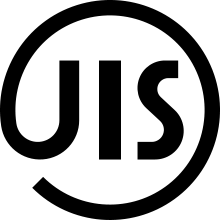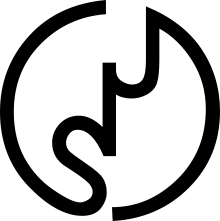Japanese Industrial Standards
Japanese Industrial Standards (JIS) (日本産業規格, Nihon Sangyō Kikaku, formerly 日本工業規格 Nihon Kōgyō Kikaku until June 30, 2019) are the standards used for industrial activities in Japan, coordinated by the Japanese Industrial Standards Committee (JISC) and published by the Japanese Standards Association (JSA). The JISC is composed of many nationwide committees and plays a vital role in standardizing activities across Japan.


History
In the Meiji era, private enterprises were responsible for making standards, although the Japanese government too had standards and specification documents for procurement purposes for certain articles, such as munitions.
These were summarized to form an official standard, the Japanese Engineering Standard, in 1921. During World War II, simplified standards were established to increase matériel output.
The present Japanese Standards Association was established after Japan's defeat in World War II in 1945. The Japanese Industrial Standards Committee regulations were promulgated in 1946, and new standards were formed.
The Industrial Standardization Law was enacted in 1949, which forms the legal foundation for the present Japanese Industrial Standards.
New JIS mark
The Industrial Standardization Law was revised in 2004 and the JIS product certification mark was changed; since October 1, 2005, the new JIS mark has been used upon re-certification. Use of the old mark was allowed during a three-year transition period ending on September 30, 2008, and every manufacturer was able to use the new JIS mark. Therefore all JIS-certified Japanese products manufactured since October 1, 2008, have had the new JIS mark.
Standards classification and numbering
Standards are named in the format "JIS X 0208:1997", where X denotes area division, followed by four digits designating the area (five digits for ISO-corresponding standards), and four final digits designating the revision year.
Divisions of JIS and significant standards are:
- A – Civil engineering and architecture
- B – Mechanical engineering
- JIS B 7021:2013 – Water resistant watches for general use—Classification and water resistance
- JIS B 7512:2016 – Steel tape measures
- JIS B 7516:2005 – Metal rules
- C – Electronics and electrical engineering
- JIS C 0920:2003 – Degrees of protection provided by enclosures (IP Code)
- JIS C 5062:2008 – Marking codes for resistors and capacitors
- JIS C 5063:1997 – Preferred number series for resistors and capacitors
- JIS C 7001 – Type designation system for electronic tubes[1]
- JIS C 7012 – Type designation system for discrete semiconductor devices
- JIS C 8800:2008 – Glossary of terms for fuel cell power systems
- D – Automotive engineering
- E – Railway engineering
- F – Ship building
- G – Ferrous materials and metallurgy
- JIS G 3101 – Rolled steels for general structure
- JIS G 3103 – Carbon steel and molybdenum alloy steel plates for boilers and pressure vessels
- JIS G 3106 – Rolled steels for welded structure
- JIS G 3108 – Rolled carbon steel for cold-finished steel bars
- JIS G 3114 - Hot-rolled atmospheric corrosion resisting steels for welded structure
- JIS G 3115 – Steel plates for pressure vessels for intermediate temperature service
- JIS G 3118 – Carbon steel plates for pressure vessels for intermediate and moderate temperature services
- JIS G 3126 – Carbon steel plates for pressure vessels for low temperature service
- JIS G 4304 – Hot-rolled stainless steel plate, sheet and strip
- JIS G 4305 – Cold-rolled stainless steel plate, sheet and strip
- H – Nonferrous materials and metallurgy[2]
- JIS H 2105 – Pig lead
- JIS H 2107 – Zinc ingots
- JIS H 2113 – Cadmium metal
- JIS H 2116 – Tungsten powder and tungsten carbide powder
- JIS H 2118 – Aluminum alloy ingots for die castings
- JIS H 2121 – Electrolytic cathode copper
- JIS H 2141 – Silver bullion
- JIS H 2201 – Zinc alloy ingots for die casting
- JIS H 2202 – Copper alloy ingots for castings
- JIS H 2211 – Aluminium alloy ingots for castings
- JIS H 2501 – Phosphor copper metal
- JIS H 3100 – Copper and copper alloy sheets, plates and strips
- JIS H 3110 – Phosphor bronze and nickel silver sheets, plates and strips
- JIS H 3130 – Copper beryllium alloy, copper titanium alloy, phosphor bronze, copper-nickel-tin alloy and nickel silver sheets, plates and strips for springs
- JIS H 3140 – Copper bus bars
- JIS H 3250 – Copper and copper alloy rods and bars
- JIS H 3260 – Copper and copper alloy wires
- JIS H 3270 – Copper beryllium alloy, phosphor bronze and nickel silver rods, bars and wires
- JIS H 3300 – Copper and copper alloy seamless pipes and tubes
- JIS H 3320 – Copper and copper alloy welded pipes and tubes
- JIS H 3330 – Plastic covered copper tubes
- JIS H 3401 – Pipe fittings of copper and copper alloys
- JIS H 4000 – Aluminium and aluminium alloy sheets and plates, strips and coiled sheets
- JIS H 4001 – Painted aluminium and aluminium alloy sheets and strips
- JIS H 4040 – Aluminium and aluminium alloy rods, bars and wires
- JIS H 4080 – Aluminium and aluminium alloys extruded tubes and cold-drawn tubes
- JIS H 4090 – Aluminium and aluminium alloy welded pipes and tubes
- JIS H 4100 – Aluminium and aluminium alloy extruded shape
- JIS H 4160 – Aluminium and aluminium alloy foils
- JIS H 4170 – High purity aluminium foils
- JIS H 4301 – Lead and lead alloy sheets and plates
- JIS H 4303 – DM lead sheets and plates
- JIS H 4311 – Lead and lead alloy tubes for common industries
- JIS H 4461 – Tungsten wires for lighting and electronic equipments
- JIS H 4463 – Thoriated tungsten wires and rods for lighting and electronic equipment
- JIS H 4631 – Titanium and titanium alloy tubes for heat exchangers
- JIS H 4635 – Titanium and titanium alloy welded pipes
- JIS H 5401 – White metal
- JIS H 8300 – Thermal spraying―zinc, aluminium and their alloys
- JIS H 8601 – Anodic oxide coatings on aluminium and aluminium alloys
- JIS H 8602 – Combined coatings of anodic oxide and organic coatings on aluminium and aluminium alloys
- JIS H 8615 – Electroplated coatings of chromium for engineering purposes
- JIS H 8641 – Zinc hot dip galvanizings
- JIS H 8642 – Hot dip aluminized coatings on ferrous products
- K – Chemical engineering
- L – Textile engineering
- M – Mining
- P – Pulp and paper
- Q – Management systems
- JIS Q 9001 - Quality management systems - requirements
- JIS Q 14001 - Environment management systems - requirements with guidance for use
- JIS Q 15001 - Personal information protection management systems - requirements
- JIS Q 20000-1 - IT service management - specification
- JIS Q 27001 - Information security management systems - requirements
- R – Ceramics
- S – Domestic wares
- T – Medical equipment and safety appliances
- W – Aircraft and aviation
- X – Information processing
- JIS X 0201:1997 – Japanese national variant of the ISO 646 7-bit character set
- JIS X 0202:1998 – Japanese national standard which corresponds to the ISO 2022 character encoding
- JIS X 0208:1997 – 7-bit and 8-bit double byte coded kanji sets for information interchange
- JIS X 0212:1990 – Supplementary Japanese graphic character set for information interchange
- JIS X 0213:2004 – 7-bit and 8-bit double byte coded extended Kanji sets for information interchange
- JIS X 0221-1:2001 – Japanese national standard which corresponds to ISO 10646
- JIS X 0401:1973 – Todofuken (prefecture) identification code
- JIS X 0402:2003 – Identification code for cities, towns and villages
- JIS X 0405:1994 – Commodity classification code
- JIS X 0408:2004 – Identification code for universities and colleges
- JIS X 0501:1985 – Bar code symbol for uniform commodity code
- JIS X 0510:2004 – QR code
- JIS X 3001-1:2009, JIS X 3001-2:2002, JIS X 3001-3:2000 – Fortran programming language
- JIS X 3002:2001 – COBOL
- JIS X 3005-1:2010 – SQL
- JIS X 3010:2003 – C programming language
- JIS X 3014:2003 – C++
- JIS X 3017:2011, JIS X 3017:2013 – Programming languages – Ruby
- JIS X 3030:1994 – POSIX - repealed in 2010
- JIS X 4061:1996 – Collation of Japanese character string
- JIS X 6002:1980 – Keyboard layout for information processing using the JIS 7 bit coded character set
- JIS X 6054-1:1999 – MIDI
- JIS X 6241:2004 – 120 mm DVD – Read-only disk
- JIS X 6243:1998 – 120 mm DVD Rewritable Disk (DVD-RAM)
- JIS X 6245:1999 – 80 mm (1.23GB/side) and 120 mm (3.95GB/side) DVD-Recordable-Disk (DVD-R)
- JIS X 6302-6:2011 - Identification cards—Recording technique—Part 6: Magnetic stripe—High coercivity
- JIS X 9051:1984 – 16-dots matrix character patterns for display devices
- JIS X 9052:1983 – 24-dots matrix character patterns for dot printers
- Z – Miscellaneous
- JIS Z 2371:2015 – Methods of salt spray testing
- JIS Z 8301:2011 – Rules for the layout and drafting of Japanese Industrial Standards
- JIS Z 9098:2016 - Hazard specific evacuation guidance sign system
- JIS Z 9112:2012 – Classification of fluorescent lamps and light emitting diodes by chromaticity and colour rendering property
See also
- International Organization for Standardization (ISO)
- International Electrotechnical Commission (IEC)
- Japanese Agricultural Standards
- Korean Standards Association
- Japanese typographic symbols – gives the Unicode symbol for the Japanese industrial standard
- List of JIS categories (in Japanese)
References
- HAYASHI, Koji; JAPAN, Ibaraki, Tube Naming System Japan, retrieved 2017-02-28
- List of JIS that is possible to certificate by JQA [sic] (PDF), archived from the original (PDF) on November 22, 2007, retrieved 2008-03-09